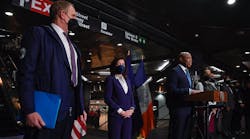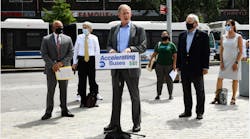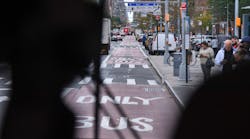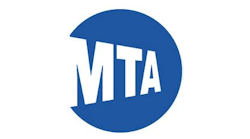NYC, MTA’s first Transit Improvement Summit produces plans to speed buses and integrate transit options
New York City officials met with Metropolitan Transportation Authority (MTA) representatives in the first Transit Improvement Summit, a quarterly effort to bolster collaboration between the city and the transit authority to improve reliability, ease and safety of transit services.
The meeting produced a plan to speed buses, increase accessibility, integrate transportation options and improve safety on the MTA network.
“This partnership is the definition of ‘Get Stuff Done,’” said New York City Mayor Eric Adams. “Together with the MTA, we are delivering the efficient, reliable bus network and transit system all New Yorkers and visitors to our great city deserve. And we will work closely with communities every step of the way to take these much-needed, bold steps together.”
Improving MTA’s bus network will be prioritized with MTA and New York City Department of Transportation (NYCDOT) planning to complete 150 miles of new and enhanced bus lanes and busways over the next four years. In 2022, that effort will begin with 20 miles of bus lanes on the following corridors:
- Fordham Road and 207th Street, between 10th Avenue and White Plains Road in Manhattan and the Bronx (3.0 miles);
- Gun Hill Road, between Bainbridge Avenue and Bartow Avenue in the Bronx (3.8 miles);
- University Avenue, between Kingsbridge Road and Washington Bridge in the Bronx (3.4 miles);
- Westchester Avenue at Pelham Bay Park Station in the Bronx (0.1 miles);
- First Avenue between 61st Street and 79th Street in Manhattan (0.9 miles);
- Avenues A and D, various segments in Manhattan (1.0 mile);
- 21st Street, between the RFK Bridge and the Queensboro Bridge in Queens (3.4 miles); and
- Northern Boulevard, between Broadway and 114th Street in Queens (5.4 miles).
Additionally, NYCDOT will make permanent the Main Street busway in Queens, which launched as a pilot in January 2021. The busway has increased bus speeds by up to 50 percent and supports 155,000 riders per day.
The city and the MTA will also immediately launch planning and community outreach for the next round of new bus priority projects at five locations including Tremont Avenue in the Bronx, Flatbush Avenue in Brooklyn, Livingston Street in Brooklyn, Northern Broadway in Manhattan and Second Avenue in Manhattan.
The city explains these critical bus corridor priorities will complement ongoing bus network redesign projects to make service faster, more frequent and more reliable. The Bronx Local Bus Network Redesign will be implemented on June 26, and public engagement on the Queens Local Bus Network Redesign draft plan is ongoing. The MTA will also release a draft bus network redesign plan for Brooklyn and kick-off public engagement by the end of 2022.
To further speed up buses, NYCDOT will expand automated enforcement and transit signal priority at traffic signals, installing 50 additional fixed bus lane cameras on new and existing bus lanes — on top of the previous commitment to install 50 cameras.
The MTA will match this commitment by expanding the on-bus Automated Bus Lane Enforcement (ABLE) program from the current 123 buses across seven routes on the ABLE program to another 300 buses by the end of 2022, covering an additional nine routes across all five boroughs.
To maximize the cameras’ impact, MTA and NYCDOT will jointly engage state lawmakers to advance future bus camera enforcement legislation in Albany that would (1) make the existing ABLE program permanent and (2) expand automated bus and stationary camera enforcement of certain city traffic rules — including double parking and illegal parking at bus stops — to speed up bus trips for riders across New York City.
The MTA and NYCDOT will also prioritize bicycle, micromobility and pedestrian access to transit with improvements to bike infrastructure, additional bike parking and positioning shared micromobility systems near subway stations and major bus stops. The MTA will also ensure that pedestrian curb ramps that are impacted by capital projects are replaced by accessible curb ramps built to modern accessibility standards. This work will be formalized in the MTA’s Strategic Action Plan released at the end of 2022.
“New Yorkers deserve a world-class transit system, and both the MTA and city leadership are committed to working together to bring real, tangible improvements for our riders,” said MTA Chair and CEO Lieber. “This is a new era of city-MTA collaboration that will speed up buses, make the subways safer and more reliable, and prioritize equity and accessibility in mass transit. I thank Mayor Adams and his team and look forward to our continued work ahead.”
Additionally, MTA will continue to address quality-of-life issues in the subway system. The transit authority has made a $200 million commitment to expand subway countdown clocks, improve public announcement systems and integrate LCD signage at 71 subway stations most in need of upgrades.
In addition, the MTA and city are coordinating to combat fare and toll evasion, beginning with a crackdown on defaced and fraudulent temporary license plates, which cost the city and the MTA more than $100 million combined per year in lost revenue and are correlated to other criminal behavior.
As the partnership continues, the MTA and the city have agreed to collaborate in several critical areas for providing the transit system New York City deserves, including:
- Accessibility improvements to transit;
- Stormwater resiliency;
- Connecting transit-oriented development and neighborhood planning to transportation infrastructure investment; and
- Collaborate on fare initiatives, including the city’s Fair Fares program, Freedom Ticket, and CityTicket for Metro-North and Long Island Rail Road.
This new partnership comes as the city and the MTA have been implementing the Subway Safety Plan with a focus on providing social services and access to shelter at end-of-line stations to New Yorkers sheltering in the subway system. As part of this effort, MTA and city staff working groups have been meeting regularly since January to craft solutions to New York City’s transit challenges and improve service for riders.
“This partnership is improving the customer experience for everyone who uses New York City Transit,” said New York City Transit President Richard Davey. “The commitment of Mayor Adams and his administration to this collaborative effort will make a difference, and I am excited to see the enhancements we discussed today improve the rider’s experience in the coming months.”
![MTA and NYCDOT will work to improve bus service in the city with new bus lanes, expanded automated enforcement and transit signal priority at signals. [Marc A Hermann/MTA New York City Transit] MTA and NYCDOT will work to improve bus service in the city with new bus lanes, expanded automated enforcement and transit signal priority at signals. [Marc A Hermann/MTA New York City Transit]](https://img.masstransitmag.com/files/base/cygnus/mass/image/2022/06/16x9/MarcAHermann_MTANYCT_BusLanes149St_Oct2020.62ac97b8aa6dc.png?auto=format,compress&fit=max&q=45&w=250&width=250)






